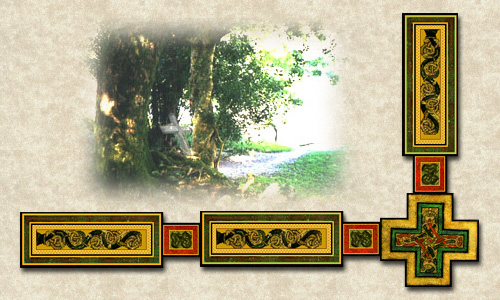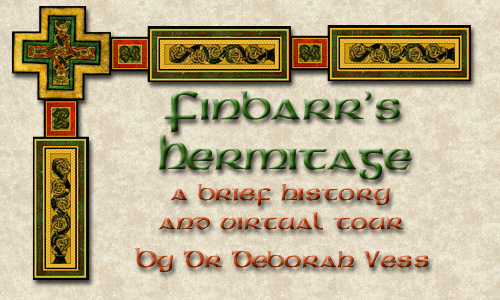
|
St. FinbarrCeltic monasticism has a strong element of asceticism and of the eremitical lifestyle. St. Finbarr (Bairre) was a seventh-century Irish hermit who lived on an island in modern Gougane Barra in Inchigeela, County Cork. Finbarr is founder and patron of the city and see of Cork, of Dornoch, the Episcopal seat of Caithness, and the island of Barra in the Hebrides. He is also the patron saint of marriage. His mother was of royal blood, while his father was said to be a master smith. They baptized him, Lochan, but the monks with whom he studied ay Kilmacahill in Kilkenny renamed him Fionnbharr, or Whitehead, in honor of his fair hair. According to legends, Finbarr went on Pilgrimage to Rome, and stopped to visit St. David on his way home. David loaned him a horse for the crossing to Ireland, and as he crossed the sea, he sighted St. Brendan the Navigator on his voyage to the east. St. Finbarr is believed to have made another trip to Rome with St. David and others. The Pope at the time was Gregory the Great, who wanted to consecrate Finbarr a bishop; a vision, however, told him that this privilege had been reserved for the Lord. When Finbarr returned to Ireland, a miraculous flow of oil came from the ground, Finbarr was taken into Heaven, and there anointed a bishop with the oil. He preached to the Irish in the south, and lived as a hermit on a small island called Louch Eiroe. He later established a monastery on the south side of the river Lee, on the corcagh mor from which the name of the city of Cork is derived. The coragh mor was built up in the lake as a fortification, a common practice in Ireland. Here, Finbarr's holiness drew many disciples to him, and his monastery became a renowned center of learning in Ireland. Finbarr must also have preached in Scotland, as his cult is strong there. The island of Barra is named for Finbarr. He died in Cloyne, and his body was taken back to Cork. According to legends, when Finbarr died, the sun did not set for two weeks. There are both Irish and Latin Lives of Finbarr. A translation of the Irish life appears in Charles Plummer, Bethada Nádem nÉrenn, vol.II. The most reliable Latin Life appears in Plummer, Vitae Sanctae Hiberniae, vol. I. Another edition was published by Caulfield, Life of St. Fin Barre (1864). Other lives can be found in the Acta Sanctorum (September, vol. VII),P. Grosjean, Analecta Bollandiana, vol. LXIX (1951). Other hagiographical information can be found in the Kalendars of the Scottish Saints, John O'Hanlon, Lives of the Irish Saints. For further reading on Christianity in Ireland consult: W.D. Simpson, The Origins of Christianity in Aberdeenshire (1925) and J.F. Kearney, Sources for the Early History of Ireland, vol. I.
Pictorial Tour
The Landscape: forests, lakes and mountains Clicking on this link will take you to a series of still photos; or click here to v view a quicklime slide show video. I highly recommend the latter as a pleasant way to walk through the landscape.
Return to Celtic Monasticism Index Return to Celtic Monasticism: Pilgrimage To return to the medieval monasticim home page, click here.
|
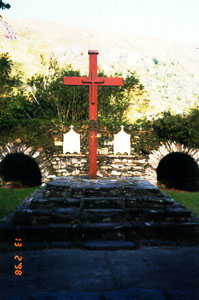 The main structure
on the island is a circular enclosure in which there are nine hermit's
cells or chapels.
The main structure
on the island is a circular enclosure in which there are nine hermit's
cells or chapels. 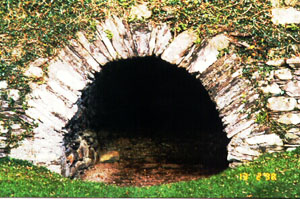 The chapels are dedicated
to saints, and there is a stone in each which serves as an altar. A
cross has been erected in the center of the compound. Once, great numbers
of pilgrims came to Gougane Barra to say their rounds, or rosary, around
this circle of cells.
The chapels are dedicated
to saints, and there is a stone in each which serves as an altar. A
cross has been erected in the center of the compound. Once, great numbers
of pilgrims came to Gougane Barra to say their rounds, or rosary, around
this circle of cells. 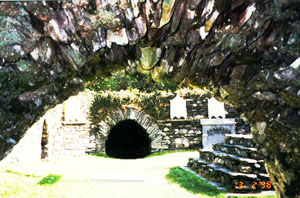 Here is a view from
the inside of one of the cells.
Here is a view from
the inside of one of the cells.  Today there are
stations of the cross inside the walls around which the faithful pray.
Today there are
stations of the cross inside the walls around which the faithful pray.

